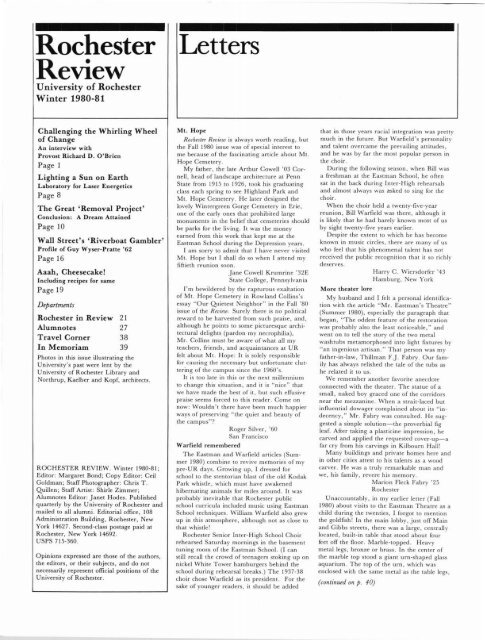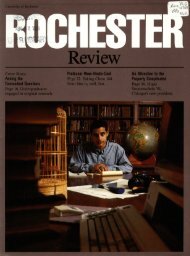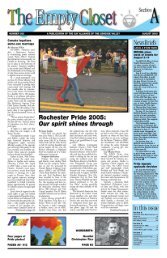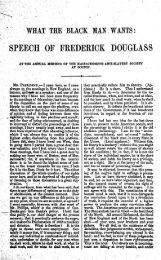Download PDF - University of Rochester Libraries
Download PDF - University of Rochester Libraries
Download PDF - University of Rochester Libraries
You also want an ePaper? Increase the reach of your titles
YUMPU automatically turns print PDFs into web optimized ePapers that Google loves.
<strong>Rochester</strong><br />
Review<br />
<strong>University</strong> <strong>of</strong> <strong>Rochester</strong><br />
Winter 1980-81<br />
Challenging the Whirling Wheel<br />
<strong>of</strong> Change<br />
An interview with<br />
Provost Richard D. O'Brien<br />
Page 1<br />
Lighting a Sun on Earth<br />
Laboratory for Laser Energetics<br />
Page 8<br />
The Great 'Removal Project'<br />
Conclusion: A Dream Attained<br />
Page 10<br />
Wall Street's 'Riverboat Gambler'<br />
Pr<strong>of</strong>ile <strong>of</strong> Guy Wyser-Pratte '62<br />
Page 16<br />
Aaah, Cheesecake!<br />
Including recipes for same<br />
Page 19<br />
Departments<br />
<strong>Rochester</strong> in Review 21<br />
Alumnotes 27<br />
Travel Corner 38<br />
In Memoriam 39<br />
Photos in this issue illustrating the<br />
<strong>University</strong>'s past were lent by the<br />
<strong>University</strong> <strong>of</strong> <strong>Rochester</strong> Library and<br />
Northrup, Kaelber and Kopf, architects.<br />
ROCHESTER REVIEW. Winter 1980-81;<br />
Editor: Margaret Bond; Copy Editor: Ceil<br />
Goldman; Staff Photographer: Chris T.<br />
Quillen; Staff Artist: Shirle Zimmer;<br />
Alumnotes Editor: Janet Hodes. Published<br />
quarterly by the <strong>University</strong> <strong>of</strong> <strong>Rochester</strong> and<br />
mailed to all alumni. Editorial <strong>of</strong>fice, 108<br />
Administration Building, <strong>Rochester</strong>, New<br />
York 14627. Second-class postage paid at<br />
<strong>Rochester</strong>, New York 14692.<br />
USPS 715-360.<br />
Opinions expressed are those <strong>of</strong> the authors,<br />
the editors, or their subjects, and do not<br />
necessarily represent <strong>of</strong>ficial positions <strong>of</strong> the<br />
<strong>University</strong> <strong>of</strong> <strong>Rochester</strong>.<br />
Letters<br />
Mt. Hope<br />
<strong>Rochester</strong> Review is always worth reading, but<br />
the Fall 1980 issue was <strong>of</strong> special interest to<br />
me because <strong>of</strong> the fascinating article about Mt.<br />
Hope Cemetery.<br />
My father, the late Arthur Cowell '03 Cornell,<br />
head <strong>of</strong> landscape architecture at Penn<br />
State from 1915 to 1926, took his graduating<br />
class each spring to see Highland Park and<br />
Mt. Hope Cemetery. He later designed the<br />
lovely Wintergreen Gorge Cemetery in Erie,<br />
one <strong>of</strong> the early ones that prohibited large<br />
monuments in the belief that cemeteries should<br />
be parks for the living. It was the money<br />
earned from this work that kept me at the<br />
Eastman School during the Depression years.<br />
I am sorry to admit that I have never visited<br />
Mt. Hope but I shall do so when I attend my<br />
fiftieth reunion soon.<br />
Jane Cowell Krumrine '32E<br />
State College, Pennsylvania<br />
I'm bewildered by the rapturous exaltation<br />
<strong>of</strong> Mt. Hope Cemetery in Rowland Collins's<br />
essay "Our Quietest Neighbor" in the Fall '80<br />
issue <strong>of</strong> the Review. Surely there is no political<br />
reward to be harvested from such praise, and,<br />
although he points to some picturesque architectural<br />
delights (pardon my necrophilia),<br />
Mr. Collins must be aware <strong>of</strong> what all my<br />
teachers, friends, and acquaintances at UR<br />
felt about Mt. Hope: It is solely responsible<br />
for causing the necessary but unfortunate cluttering<br />
<strong>of</strong> the campus since the 1960's.<br />
It is too late in this or the next millennium<br />
to change this situation, and it is "nice" that<br />
we have made the best <strong>of</strong> it, but such effusive<br />
praise seems forced to this reader. Come on<br />
now: Wouldn't there have been much happier<br />
ways <strong>of</strong> preserving "the quiet and beauty <strong>of</strong><br />
the campus"?<br />
Roger Silver, '60<br />
San Francisco<br />
Warfield remembered<br />
The Eastman and Warfield articles (Summer<br />
1980) combine to revive metnories <strong>of</strong> my<br />
pre-UR days. Growing up, I dressed for<br />
school to the stentorian blast <strong>of</strong> the old Kodak<br />
Park whistle, which must have awakened<br />
hibernating animals for miles around. It was<br />
probably inevitable that <strong>Rochester</strong> public<br />
school curricula included music using Eastman<br />
School techniques. William Warfield also grew<br />
up in this atmosphere, although not as close to<br />
that whistle!<br />
<strong>Rochester</strong> Senior Inter-High School Choir<br />
rehearsed Saturday mornings in the basement<br />
tuning room <strong>of</strong> the Eastman School. (I can<br />
still recall the crowd <strong>of</strong> teenagers stoking up on<br />
nickel White Tower hamburgers behind the<br />
school during rehearsal breaks.) The 1937-38<br />
choir chose Warfield as its president. For the<br />
sake <strong>of</strong> younger readers, it should be added<br />
that in those years racial integration was pretty<br />
much in the future. But Warfield's personality<br />
and talent overcame the prevailing attitudes,<br />
and he was by far the most popular person in<br />
the choir.<br />
During the following season, when Bill was<br />
a freshman at the Eastman School, he <strong>of</strong>ten<br />
sat in the back during Inter-High rehearsals<br />
and almost always was asked to sing for the<br />
choir.<br />
When the choir held a twenty-five-year<br />
reunion, Bill Warfield was there, although it<br />
is likely that he had barely known most <strong>of</strong> us<br />
by sight twenty-five years earlier.<br />
Despite the extent to which he has become<br />
known in music circles, there are many <strong>of</strong> us<br />
who feel that his phenomenal talent has not<br />
received the public recognition that it so richly<br />
deserves.<br />
Harry C. Wiersdorfer '43<br />
Hamburg, New York<br />
More theater lore<br />
My husband and I felt a personal identification<br />
with the article "Mr. Eastman's Theatre"<br />
(Summer 1980), especially the paragraph that<br />
began, "The oddest feature <strong>of</strong> the restoration<br />
was probably also the least noticeable," and<br />
went on to tell the story <strong>of</strong> the two metal<br />
washtubs metamorphosed into light fixtures by<br />
"an ingenious artisan." That person was my<br />
father-in-law, Thillman F.J. Fabry. Our family<br />
has always relished the tale <strong>of</strong> the tubs as<br />
he related it to us.<br />
We remember another favorite anecdote<br />
connected with the theater. The statue <strong>of</strong> a<br />
small, naked boy graced one <strong>of</strong> the corridors<br />
near the mezzanine. When a strait-laced but<br />
influential dowager complained about its "indecency,"<br />
Mr. Fabry was consulted. He suggested<br />
a simple solution-the proverbial fig<br />
leaf. After taking a plasticine impression, he<br />
carved and applied the requested cover-up-a<br />
far cry from his carvings in Kilbourn Hall!<br />
Many buildings and private homes here and<br />
in other cities attest to his talents as a wood<br />
carver. He was a truly remarkable man and<br />
we, his family, revere his memory.<br />
Marion Fleck Fabry '25<br />
<strong>Rochester</strong><br />
Unaccountably, in my earlier letter (Fall<br />
1980) about visits to the Eastman Theatre as a<br />
child during the twenties, I forgot to mention<br />
the goldfish! In the main lobby, just <strong>of</strong>f Main<br />
and Gibbs streets, there was a large, centrally<br />
located, built-in table that stood about four<br />
feet <strong>of</strong>f the floor. Marble-topped. Heavy<br />
metal legs, bronze or brass. In the center <strong>of</strong><br />
the marble top stood a giant urn-shaped glass<br />
aquarium. The top <strong>of</strong> the urn, which was<br />
enclosed with the same metal as the table legs,<br />
(continued on p. 40)
















